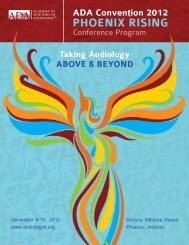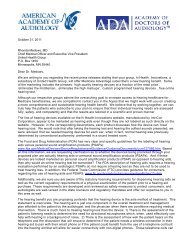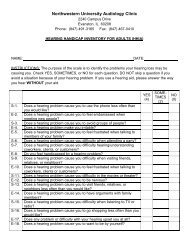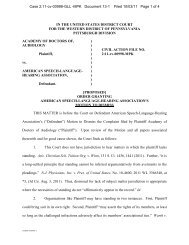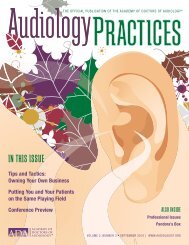Balance Sheets Income statements, and Statements of Cash Flow.pdf
Balance Sheets Income statements, and Statements of Cash Flow.pdf
Balance Sheets Income statements, and Statements of Cash Flow.pdf
You also want an ePaper? Increase the reach of your titles
YUMPU automatically turns print PDFs into web optimized ePapers that Google loves.
The State <strong>of</strong> <strong>Statements</strong>:<strong>Balance</strong> <strong>Sheets</strong>, <strong>Income</strong> <strong>Statements</strong><strong>and</strong> <strong>Statements</strong> <strong>of</strong> <strong>Cash</strong> <strong>Flow</strong>Robert M. Traynor, Ed.D., MBACEO/AudiologistAudiology Associates, Inc.Johnstown, ColoradoRobert G. Glaser, Ph.D.CEO/AudiologistAudiology Associates <strong>of</strong> Dayton, IncDayton, OhioIntroductionFor most audiologists the patient is foremost in mind as weprovide hearing care services. Successful practitioners know thatwhen their practice is centered on their patient’s welfare, successwill usually follow. Probably the greatest responsibility <strong>of</strong> thepatient-centric practitioner is to be in business next year when thepatient needs things that are warranty items,or other services thatmay be <strong>of</strong> benefit to them. There are many stories <strong>of</strong> highly suc-Continued On Next PageFEEDBACK • VOLUME 19, NUMBER 3 • FALL 20087
Feature The State <strong>of</strong> <strong>Statements</strong>cessful practices that did not survive for onereason or another. These failures are mostcommonly related to poor managementpractices <strong>and</strong> less likely due to the quality<strong>of</strong> the clinical care provided.Historically, academic programs preparingaudiologists for clinical work haveeither not addressed issues <strong>of</strong> managing apractice as a business entity or have <strong>of</strong>feredlimited information as a part <strong>of</strong> a courserather than <strong>of</strong>fering an entire course inpractice management. Contemporary programsare <strong>of</strong>fering comprehensive coursesin practice management, increasing thelikelihood for not only surviving the firstfew years <strong>of</strong> practice but optimizing thechances for success in the hard fought world<strong>of</strong> today’s health care market place. Whenentering independent, private practice,audiologists must be well prepared toaddress the multi-faceted challenge that ispractice management. They must have theessential tools needed to monitor, manage<strong>and</strong> maintain their business to pr<strong>of</strong>itability.Thus,to be a good manager,clinicians musthave the capability to digest informationabout the financial performance <strong>of</strong> thepractice <strong>and</strong> develop the background totranslate that information into decisionsthat move the practice toward pr<strong>of</strong>itability.Although it is not necessary to obtain anMBA in order to know how to run yourpractice or an audiology pr<strong>of</strong>it center withina hospital, educational, or other institutionalsetting, courses in businessmanagement, accounting <strong>and</strong> finance aresubstantially beneficial <strong>and</strong> readily availableat most local community colleges. Thesecourses <strong>of</strong>fer the practitioner greater insightinto the management <strong>of</strong> their practice <strong>and</strong>gives them the power to interpret the relevantbusiness variables. The following discussionis an attempt to orient clinicians tothe basics <strong>of</strong> the <strong>Balance</strong> Sheet, <strong>Income</strong>Statement <strong>and</strong>, probably most important,the Statement <strong>of</strong> <strong>Cash</strong> <strong>Flow</strong>s.Financial <strong>Statements</strong>Most <strong>of</strong> us use the services <strong>of</strong> anaccountant to prepare reports <strong>and</strong> to assistus in the interpretation <strong>of</strong> the informationthey contain. Traynor (2008) suggests thatpractitioners should have knowledge <strong>of</strong>the vocabulary <strong>and</strong> language <strong>of</strong> accountingto effectively communicate with the8 FEEDBACK • VOLUME 19, NUMBER 3 • FALL 2008accounting (<strong>and</strong> bookkeeping) pr<strong>of</strong>essionalswho manage their practice <strong>and</strong> protecttheir assets. Although it is the bookkeeperor <strong>of</strong>fice manager in the practice thatenters the day-to- day financial data, it isthe accountant who prepares financialreports that will assist the practice owneror manager in making evidence-baseddecisions regarding the success or failure <strong>of</strong>daily operations, a specific procedure, or anew market <strong>of</strong>fering. These reports arefundamental to underst<strong>and</strong>ing the reasonsfor positive or negative changes in the bottom-lineperformance <strong>of</strong> the practice.Such accounting reports are preparedaccording to internationally acceptedaccounting rules called the GenerallyAccepted Accounting Principles (GAAP),a universal method <strong>of</strong> valuing pr<strong>of</strong>it <strong>and</strong>measuring assets <strong>and</strong> liabilities. Althoughthey vary slightly from one country toanother, GAAP rules are used to conductaccounting in all businesses. GAAPdescribes how transactions for costs, pr<strong>of</strong>it,inventory, sales <strong>and</strong> other businessspecifics are recorded <strong>and</strong> facilitates a comparison<strong>of</strong> one business to another sincebusinesses all use these same proceduresfor accounting. While the role <strong>of</strong> anaccountant in the practice will vary fromone practice to another, his or her pr<strong>of</strong>essionalassistance, counsel <strong>and</strong> guidance <strong>of</strong>these practitioners is essential to both thelong <strong>and</strong> short term success <strong>of</strong> the practice.There are two primary objectives <strong>of</strong>every business, including audiology practices;pr<strong>of</strong>itability <strong>and</strong> solvency. Unless apractice can produce satisfactory earnings<strong>and</strong> pay its obligations in a timely manner,all other objectives will never be realizedbecause the practice will not survive.Financial <strong>statements</strong> that reflect a practice’ssolvency (the <strong>Balance</strong> Sheet), its pr<strong>of</strong>itability(the <strong>Income</strong> Statement) <strong>and</strong> a view<strong>of</strong> its financial health (the Statement <strong>of</strong><strong>Cash</strong> <strong>Flow</strong>s) provide the practitioner substantiveinformation upon which to makewell informed decisions about the operations<strong>of</strong> the practice. These financial <strong>statements</strong>are so important that bankers <strong>and</strong>other lenders depend on them to supporttheir decisions to grant credit opportunities.Bankers <strong>and</strong> lenders know that financial<strong>statements</strong> are the bases <strong>of</strong> thecalculations for business ratios that <strong>of</strong>ferimportant,informative metrics about activity,liquidity, <strong>and</strong> leverage (debt) <strong>of</strong> thepractice.<strong>Balance</strong> SheetThe <strong>Balance</strong> Sheet contains the elementalfiscal components <strong>of</strong> the practice;information about assets, liabilities <strong>and</strong>owner’s equity. It presents a snapshot <strong>of</strong> thefinancial condition <strong>of</strong> the practice at a specificmoment in time, usually at the close<strong>of</strong> an accounting period such as the end <strong>of</strong>the month, quarter, or year (Brealey et al,2002). Businesstown.com (2003a) indicatesthat the purpose <strong>of</strong> the balance sheetis to quickly review view the financialstrength <strong>and</strong> capabilities <strong>of</strong> the business aswell as answer important questions such as:• Is the business in a position to exp<strong>and</strong>?• Can the business easily withst<strong>and</strong> thenormal financial ebbs <strong>and</strong> flows <strong>of</strong> revenues<strong>and</strong> expenses?• Or should the business take immediatesteps to strengthen cash reserves?The balance sheet gets its name from thefact that the two sides <strong>of</strong> the statement
Feature The State <strong>of</strong> <strong>Statements</strong>Table 2: <strong>Income</strong> Statement (Traynor, 2008)10 FEEDBACK • VOLUME 19, NUMBER 3 • FALL 2008how efficiently the business is operating.In accounting, the practice’s pr<strong>of</strong>itabilityis measured by comparing the revenues generatedin a given period with the expensesincurred to produce those revenues. Thedifference between the revenue generated<strong>and</strong> the expenses created during the generation<strong>of</strong> the revenue is the pr<strong>of</strong>it (or loss) <strong>of</strong>the practice. In an Audiology practice,revenuesare defined as the inflow <strong>of</strong> revenuefrom providing patient care or the dispensing<strong>of</strong> products.Expenses can be consideredthe sacrifices made or the costs incurred toproduce these revenues. If revenues exceedexpenses,net earnings result while if expensesexceed net revenue, a loss is recorded.As with other financial <strong>statements</strong>, the<strong>Income</strong> Statement, presented in table 2,may be prepared for any financial reportingperiod <strong>and</strong> is used to track revenues <strong>and</strong>expenses critically important in assessingthe operating performance <strong>of</strong> the practice.Businesstown.com (2003b) suggests thatmanagers can use income <strong>statements</strong> to findareas <strong>of</strong> the practice that are over or underbudget <strong>and</strong> identify specific areas <strong>of</strong> unexpectedexpenditures. Additionally, the<strong>Income</strong> Statement tracks the increase ordecrease in product returns; cost <strong>of</strong> goodssold as a percentage <strong>of</strong> sales <strong>and</strong> presentssome indication <strong>of</strong> the extent <strong>of</strong> the practices’income tax liability. Since it is veryimportant to format an <strong>Income</strong> Statementappropriate to the type <strong>of</strong> business beingconducted, the structure <strong>of</strong> income <strong>statements</strong>may vary from one practice to another.In audiology the format may dependupon the mix <strong>of</strong> business conducted in diagnostics,hearing products, <strong>and</strong> rehabilitativeservices.Net sales on the <strong>Income</strong> Statement consist<strong>of</strong> sales figures representing the actualrevenue generated by the business.Marshall(2004) states that the Net Sales entry on the<strong>Income</strong> Statement represents the totalamount <strong>of</strong> all sales less product returns <strong>and</strong>sales discounts. Directly below the NetSales in Table 2, is the Cost Of Goods Sold(COGS). COGS are costs directly associatedwith making <strong>and</strong>/or acquiring theproducts.These costs include the acquisition<strong>of</strong> products, such as hearing aids or assistivedevices provided by outside suppliers. Ifhearing instrument are repaired or manufacturedby the practice, COGS could alsobe materials, parts, <strong>and</strong> internal expensesrelated to the manufacturing or repairprocess, such as faceplates, shells, microphones,receivers, <strong>and</strong> components.Net Pr<strong>of</strong>it, sometimes called gross pr<strong>of</strong>it,is derived by subtracting the cost <strong>of</strong> goodssold from net sales. This net pr<strong>of</strong>it, however,does not include any operating, interest,or income tax expenses. Just below the NetPr<strong>of</strong>it entry in Table 2 is a category forSelling <strong>and</strong> General AdministrativeExpenses. This subcategory is described byTracy (2001) <strong>and</strong> Marshall (2004) as a broadìcatch-allî category for all expenses exceptthose reported elsewhere in the <strong>Income</strong>Statement. Examples <strong>of</strong> selling <strong>and</strong> generaladministrative expenses that are recordedhere are legal expenses, the owner’s salary,advertising, travel <strong>and</strong> entertainment, <strong>and</strong>other similar costs.The actual income fromoperations, sometimes called EarningsBefore Interest <strong>and</strong> Taxes (EBIT) is the result<strong>of</strong> deducting the Selling <strong>and</strong> GeneralAdministrative Expenses from the NetPr<strong>of</strong>it. The earnings Before Interest <strong>and</strong>Taxes (EBIT) are the net revenue generatedby the practice. Interest expenses <strong>and</strong>taxes are subtracted to arrive at the Net<strong>Income</strong> (or Loss).<strong>Statements</strong> <strong>of</strong> <strong>Cash</strong> <strong>Flow</strong><strong>Statements</strong> <strong>of</strong> <strong>Cash</strong> <strong>Flow</strong> reflect the cashposition <strong>of</strong> the practice as well as thesources <strong>and</strong> uses <strong>of</strong> cash in the practiceduring a specified business cycle. It presentshow cash flows in <strong>and</strong> out <strong>of</strong> the practice.Monthly cash flow <strong>statements</strong> areuseful but quarterly <strong>statements</strong> <strong>of</strong> cash floware essential to provide a look at trendsthat might be developing in the overallcash-flow picture <strong>of</strong> the business. Pr<strong>of</strong>it <strong>and</strong>cash-flow are intimately related. A practicecan be highly pr<strong>of</strong>itable yet on the verge <strong>of</strong>bankruptcy if the pr<strong>of</strong>its are sequestered,forexample in the Accounts Receivable—highpr<strong>of</strong>it, low cash flow. This situation results inlimited cash to pay the practitioner,employees<strong>and</strong>/or to service the accounts payable.Conversely,if there is substantial cash inflowto a practice but excessive overhead costs thatare strangling pr<strong>of</strong>itability, financial difficultieswill ensue—low pr<strong>of</strong>it,high cash flow. Thisis a situation where in the practice owner hasoverextended available resources with illconceivedequipment purchases,exceptionalleasehold costs, or extraneous staff salaries<strong>and</strong> other questionable business decisions.To illustrate how cash flows in <strong>and</strong> out <strong>of</strong> thepractice, Marshall (2004) indicates that the<strong>Statements</strong> <strong>of</strong> <strong>Cash</strong> <strong>Flow</strong> are used to identifythe sources <strong>and</strong> uses <strong>of</strong> cash over time <strong>and</strong>Continued On Page 26
Feature The State <strong>of</strong> <strong>Statements</strong>adjustments in practice operations for managementpurposes.Table 3: Statement <strong>of</strong> <strong>Cash</strong> <strong>Flow</strong>s (Traynor, 2008)can be compared to the current period foranalysis. In Table 3, the cash flow statementis divided into three general sections, <strong>Cash</strong><strong>Flow</strong> From Operating Activities,<strong>Cash</strong> <strong>Flow</strong>from Investment Activities <strong>and</strong> <strong>Cash</strong> <strong>Flow</strong>from Financing Activities. The OperatingActivity section begins with the Net <strong>Income</strong>(taken from the <strong>Income</strong> Statement,Table 2)<strong>and</strong> includes all transactions <strong>and</strong> events thatare normally entered to determine the operatingincome. These entries include cashreceipts from selling goods or providing services,aswell as income earned as interest <strong>and</strong>dividends, if the practice has investments.<strong>Cash</strong> <strong>Flow</strong> From Operating Activities alsoincludes additions or deductions <strong>of</strong> itemsaffect cash such as depreciation, increase (ordecrease) in accounts receivable,merch<strong>and</strong>iseinventory <strong>and</strong> liabilities, resulting in theNet <strong>Cash</strong> used by Operating Activities. TheNet Amount <strong>of</strong> <strong>Cash</strong> Provided (or used) bypractice operating activities is the key figureon a Statement <strong>of</strong> <strong>Cash</strong> <strong>Flow</strong>s. TheOperations Section is <strong>of</strong> the most interestsince it presents the specific areas <strong>of</strong> the practicewhere cash was consumed by the running<strong>of</strong> the practice.The second section <strong>of</strong> a Statement <strong>of</strong> <strong>Cash</strong><strong>Flow</strong>s reviews <strong>Income</strong> generated frominvesting activities. This section includestransactions <strong>and</strong> events involving the purchase<strong>and</strong> sale <strong>of</strong> equipment,securities,l<strong>and</strong>,buildings,<strong>and</strong> other assets not generally heldin the practice for resale. This area <strong>of</strong> thestatement also covers the making <strong>and</strong> collecting<strong>of</strong> loans, if the practice internallyfinances products <strong>and</strong> services these loans toconsumers internally.Investing Activities arenot classified as operating activities sincethey have an indirect relationship to the central,ongoing operation <strong>of</strong> the practice.Transactions within the third section record<strong>Cash</strong> <strong>Flow</strong>s from Financing Activities <strong>and</strong>deal with the flow <strong>of</strong> cash between the practice,theowners (stockholders),<strong>and</strong> creditorsas well as the cash proceeds from issuingcapital stock or bonds if applicable. Forexample,if there was a need to transfer pr<strong>of</strong>itfrom the practice to the owners or fromthe owners (or creditors) into the practice,it would be reflected in the <strong>Cash</strong> <strong>Flow</strong>s fromFinancing Activities section. Careful review<strong>of</strong> the Statement <strong>of</strong> <strong>Cash</strong> <strong>Flow</strong>s can <strong>of</strong>fervaluable information to the practitioner as towhere the cash generated actually goes <strong>and</strong>presents an invaluable opportunity to makeEpilogueAlthough these <strong>statements</strong> are extremelyuseful,as indicated by Freeman (2000),thesedata are simply numbers. To unlock the realinformation in these <strong>statements</strong>, it isnecessary to conduct liquidity, activity <strong>and</strong>leverage (debt) ratio calculations. Althoughthese can be conducted on all <strong>of</strong> the <strong>statements</strong>,the ratios <strong>of</strong> primary importanceare conducted on the balance sheet <strong>and</strong>income statement data. These financialaccounting ratios can give the practitionerpowerful information about whether thereare adequate funds to pay the bills, howlong it takes to turn the accounts receivable<strong>and</strong> provide meaningful information as tothe debt <strong>of</strong> the practice. In the next issue<strong>of</strong> Feedback, the continuation <strong>of</strong> this topicwill discuss the calculation <strong>of</strong> some importantratios that can influence the management<strong>of</strong> the practice as they are trackedfrom month to month, quarter to quarter,<strong>and</strong> year to year. ■Robert G. Glaser, Ph.D., FAAA, is the owner<strong>of</strong> Audiology Associates <strong>of</strong> Dayton, Inc., a multi-<strong>of</strong>fice,independent practice providing a fullrange <strong>of</strong> audiologic, neurodiagnostic <strong>and</strong> hearing<strong>and</strong> balance rehabilitative services for children <strong>and</strong>adults. Dr. Glaser is widely known for his innovativebusiness approach to the pr<strong>of</strong>ession throughwritings, presentations <strong>and</strong> seminars across thecountry. He is the principal owner <strong>of</strong> the AurisGroup, a practice management consulting firmserving health care practices <strong>and</strong> practitioners inaudiology,medicine <strong>and</strong> allied health care practices.Robert Traynor,Ed.D.,MBA is CEO <strong>and</strong> practicingaudiologist at Audiology at AudiologyAssociates,Inc.,Greeley <strong>and</strong> Johnstown,Coloradowith particular emphasis in amplification <strong>and</strong>operative monitoring <strong>of</strong>fering all general audiologicalservices to patients <strong>of</strong> all ages. An AssociateAffiliate Pr<strong>of</strong>essor at the University <strong>of</strong> ColoradoHealth Sciences Center <strong>and</strong> the University <strong>of</strong>Northern Colorado,each academic session he continuesto teach doctoral level Audiology studentsas an Adjunct Pr<strong>of</strong>essor <strong>of</strong> Audiology at theUniversity <strong>of</strong> Florida,Gainesville <strong>and</strong> the PCOSchool <strong>of</strong> Audiology in Elkins Park, PA. Apractice manager for over 35 years,Dr.Traynor haslectured on most aspects <strong>of</strong> the field <strong>of</strong> Audiologyin over 40 countries including the United States.26 FEEDBACK • VOLUME 19, NUMBER 3 • FALL 2008



